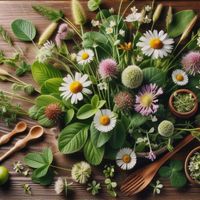Natural Resilience
Precious Knowledge for Real Crisis and Emergency Situations
Knowledge about edible wild plants strengthens our natural resilience. It fosters independence, deepens our connection to the natural world, and empowers us to act mindfully and safely in emergency situations — even without digital tools.
When was the last time you foraged for edible plants?
- Never?
- A long time ago?
- Not interested?
- Not part of your usual menu?
Then take this as your gentle reminder: don’t wait for a crisis to begin learning. Don’t wait until the moment you need this knowledge — only to find there’s no mobile signal, no search engine, no app to ask what’s edible and what’s not.
You can begin today. The richness of our natural world is waiting to be rediscovered — from aromatic wild herbs to nourishing seeds.
Why foraging knowledge makes us resilient
Learning to identify edible plants is so much more than a survival tactic. It’s:
- a powerful mindfulness practice
- a way to reconnect with our environment
- a skill that builds independence and confidence
- a gift that brings comfort and nourishment in hard times
Every plant you can identify adds to your ability to care for yourself and your loved ones — especially in uncertain situations.
Edible Plants – Your Pocket Garden of Resilience
This is not a recipe — it’s an invitation. To explore, to observe, to reconnect with nature's quiet offerings
1. Field Pennycress Edible
- young leaves, tender shoots, flowers, and roots
- Harvest season: March to May
- Tip: lightly peppery — perfect raw in salads
2. Wild Watercress
- Location: streams, brooks, shallow water
- Edible: leaves and fresh-growing tips
- Bonus: rich in Vitamin C and A — harvest with care near clean water
3. Common Daisy
- Edible: young leaves and delicate blossoms
- Where to find: gardens, meadows, city parks
- Symbolism: quiet strength and everyday beauty
4. Salad Burnet (Little Meadow Button)
- Edible: leaves and small flowers
- Taste: mild, cucumber-like
- Habitat: roadside edges, grassy meadows
5. Gallant Soldier / Buttonweed
- Edible: leaves, buds, and flowers
- Harvest: April through September
- Nutritional value: iron, Vitamin A, C, calcium — and easy to recognize
6. Dandelion (also known as Puffball)
- Leaves: harvest March to April
- Roots: best from September onward Blossoms: edible raw or gently steamed
- Effect: slightly bitter, but revitalizing and grounding
7. White Clover
- Edible: young leaves and flowers
- Nutritional benefit: a source of high-quality plant protein and essential amino acids
- Special: easy to digest, cholesterol-free, often overlooked
8. Wild Mallow
- Edible: leaves (before blooming) and its vibrant flowers
- Taste: soft, mild Benefits: rich in protein and iron — and beautiful as an edible garnish
9. Wild Berries
- Includes: wild strawberry, raspberry, blackberry, blueberry
- Seasonal and powerful: antioxidant-rich, energizing, and simply delicious
Knowledge that strengthens communities and why edible knowledge is more than just survival
This knowledge goes beyond individual survival: it is a social treasure that can provide real survival aid when shared among entire villages, circles of friends or communities — not only in times of crisis, but also in everyday life.
This knowledge is not a romantic gimmick – it is:
- Crisis competence without electricity or the internet
- Recognising instead of Googling
- Nature education in everyday life Acting instead of hesitating
- Shared strength within families and communities
- A school of life that makes us independent and connects us at the same time
If possible, create your own emergency card “Edible plants in the vicinity” – it should provide guidance in an emergency, but also encourage curious discovery in everyday life. It combines functionality with a love of nature.
Emergency Card: Edible Plants in Your Surroundings
A compact guide for emergencies, nature walks & quiet everyday resilience
Purpose & Use Cases
- Orientation during power outages or network disruptions
- Support in self-sufficiency without digital tools
- Daily training in natural observation (“What grows near me?”)
- Fits in backpack, jacket pocket, emergency binder or family kit
Design – Front Side (visual and easy to read)
- Title: “What you recognize today may help you tomorrow.”
- Sketch-style map of your local area or neighborhood
- 8 – 12 Wild Plant Icons with mini tips, such as: 🌼 Daisy – young leaves & blossoms edible 🌿 Dandelion – leaves (March–April), roots (from September) 🌱 Wild Watercress – grows near streams, rich in vitamin C 🍓 Wild Strawberry – summer fruit & leaves 🐝 White Clover – protein-rich, grows in meadows ✨ Gallant Soldier – often found in gardens, easy to spot
- Color code system: Spring / Summer / Autumn / Year-round
- Back Side (compact and useful): Quick plant notes: ➤ Harvest window ➤ Key identification tips ➤ Edible parts ➤ Caution on look-alikes
- Your Reflection prompt: “What edible plant did you personally recognize today?”
- Here I grow ... (free field for your own notes)
- Very important note: This is not a substitute for knowledge of poisonous plants – only verified knowledge should/may be applied here! If in doubt, don't eat it – always check carefully first, otherwise leave it alone!
Optional Features & Formats
- Format: Fold-out card (A6), laminated, or weatherproof sheet
- Design style: earthy colors, soft fonts, clear illustrations or your own plant photos
- QR code (optional): When the network is available, this leads to digital plant lists or learning modules on the web.
- Kid-friendly version: includes visual symbols & characters (e.g. “Daisies – bees love them too!”)
Here you can find wild plant portals that offer valuable information for both beginners and advanced users.
Pl@ntNet Identification of wild plants using photos), supports over 70,000 species, botanical families and regions can be selected, i.e. regional and thematic flora can be selected, ideal for nature walks and international identification or for documenting your own findings, also available as an app. Languages: French, English, German, and many more.
Wildpflanzen im Portrait - NABU (Germany), a lovingly maintained portal with plant portraits of native wild plants, profiles with pictures, characteristics, and ecological significance, focusing on biodiversity, insect friendliness, and nature conservation, ideal for nature education, garden planning, or wild herb knowledge.
US Wildflower Database (US), a comprehensive, lovingly maintained portal focusing on wildflowers and edible plants in the USA. Over 1,200 species with photos, botanical information, and distribution maps, filterable by state (e.g., “Wildflowers of California”), includes many edible and medicinal plants, ideal for nature observation, identification, and education.
CanPlant – Carolinian Canada Extensive database of native plant species in Canada, focusing on scientific and traditional information, supporting ecological restoration, urban greening, and education, platform for exchange between experts, communities, and learners, ideal for wild plant projects in urban and rural areas.
National Plant Monitoring Scheme (NPMS) Citizen science project for observing wild plants in UK habitats, database with indicator species, distribution & identification aids, participation for beginners & advanced learners possible, scientifically sound but accessible, promotes active nature learning & biodiversity awareness.
The Weihenstephan-Triesdorf University of Applied Sciences (HSWT) is also a real treasure trove when it comes to wild plants, nature education, and applied resilience research. The Weihenstephan Gardens. A living open-air laboratory with over seven themed gardens, including: A viewing garden and small vegetable garden ➤ Here, edible plants, wild herbs, and useful plants are observed, cultivated, and researched throughout the year. An orchard trail and arboretum ➤ Ideal for teaching about edible plants, biodiversity, and ecological self-sufficiency. Regular Sunday tours (free of charge) ➤ Topics such as “Insects in the garden,” “Good climate trees,” and “Summer pruning of fruit trees” – perfect for building resilience in everyday life. Dipl.-Ing. Steffen Guido Fleischhauer, author of the Encyclopedia of Edible Wild Plants, is a graduate of the Weihenstephan University of Applied Sciences. ➤ His work combines knowledge of wild plants with landscape planning, nutrition, and crisis preparedness.
Perhaps I have inspired you to create your very own teaching module on “Wild Plants, Education & Resilience” based on the motto “Where education takes root. Where wilderness can teach” that combines the power of the Weihenstephan Gardens with the vision of a natural, resilient life. Perhaps there are also orchard meadows, a viewing garden, or a vegetable trail near you where you can experience wild plants throughout the annual cycle?
Why not turn it into a clever project idea: “Edible school/university” or “Herbal path of resilience.” Based on the motto: French weed between paving stones – tolerance to disruption as a teacher. I'm thinking of hands-on plant education, i.e., nature walks with plant drawing and sensory identification, or simply creating a few wonderful rituals such as flower meditation, seed sharing, and herbarium work.
Reflection Set: Natural Resilience, discover your inner wild plant expertise & Edible Plants
Notice what grows. And notice yourself. What do you really need? What grows around you? And what sustains you when everything else falters?
15 questions about self-awareness and nature skills
- What would my school/college smell like if it were a garden?
- Which plant symbolizes my attitude?
- What do roots teach me about my own life?
- When was the last time I recognized with my own eyes what is actually edible around me?
- Would I be able to find a meal in nature — without an app, without searching?
- What was the last plant I touched without just seeing it as “weed”?
- Did I consciously smell, touch, or taste something, or did I just consume it?
- How would I describe my surroundings using my senses — without technology?
- Do I feel safe when I don't have a label in front of me?
- Do I have an inner sense of the seasons and their edible cycles?
- Where does my trust in my knowledge of nature end where does dependence begin?
- Which plant could feed me today – if I only allowed myself to recognize it?
- What would I teach my child if we went for a walk together in nature?
- How does my view of plants change when I see them not as “green mass” but as possibilities?
- What ancient knowledge may already lie dormant within me, unnamed – but effective?
How to Use This Set
- As daily or weekly journaling prompts
- In mindfulness or nature education workshops
- For personal crisis prevention planning with heart
- In groups for self-awareness or resilience-based teamwork
Discover what you can already see today
A walk becomes a wild plant expedition. A picnic becomes mindfulness training. A dandelion becomes a little superpower. A daisy by the side of the path. A clover in the park. A herb you thought was a weed can become a silent source of strength for you.
“I had no idea how much edible stuff I encounter every day until I stopped and looked.”
“What looks like a weed today could be your most important resource tomorrow.”
Enjoy recognizing, searching, discovering and savoring them!
This contribution was written by Birgit Bortoluzzi, the creative founder of the “University of Hope” – an independent knowledge platform with a mission: to make resilience, education, and compassion visible and audible in a complex world.



